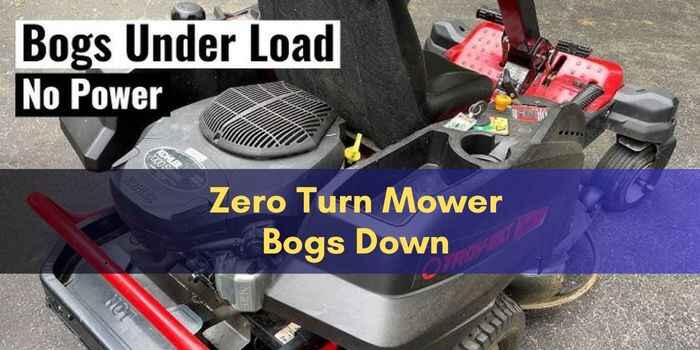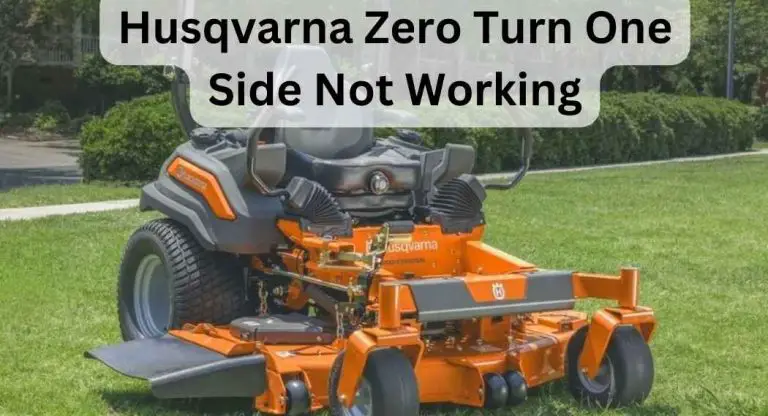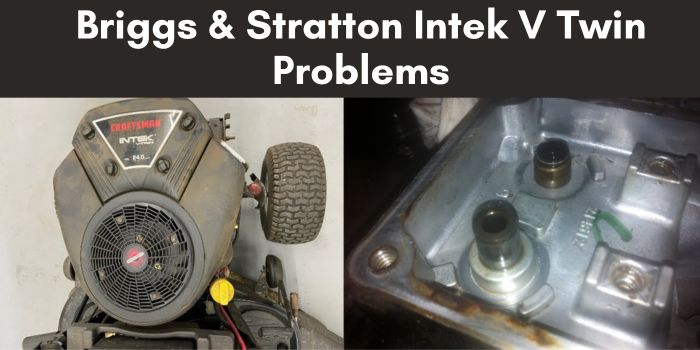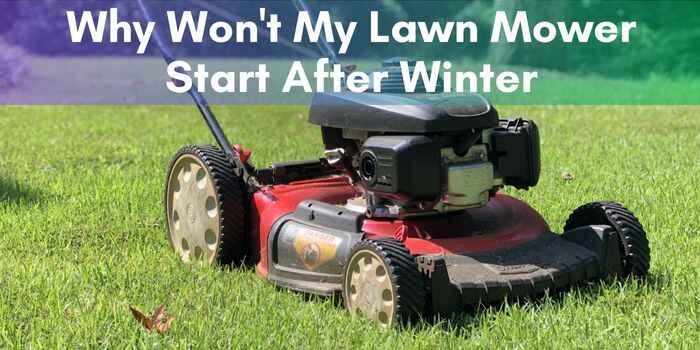Zero Turn Mower Bogs Down: Troubleshoot Grass Cutting Woes
A zero turn mower that bogs down when cutting grass typically has either a clogged air filter or dull blades. It could also be due to a fuel system issue or an overloaded engine.
Zero turn mowers revolutionized lawn maintenance with their agility and speed, but operational hiccups can temper their efficiency.
One common issue owners face is a mower that struggles and bogs down while cutting grass, which can transform a quick task into a tedious chore.
This performance dip often points to a maintenance need, signaling it’s time to inspect and service your machine.
Ensuring the mower blades are sharp, the fuel system is clean, and the engine isn’t burdened beyond its capacity keeps your zero turn mower in peak condition.
Timely attention to these areas not only prevents bogging down but also prolongs the life of your mower, making it a reliable tool for pristine lawns.
The Symptoms Of A Bogs-down Zero Turn Mower
Identifying the signs of a bogging zero turn mower is key to smooth lawn care. Performance issues can be both frustrating and time-consuming. This section will explore the common symptoms that indicate your mower may need attention.
Engine Sputtering Or Stalling
Irregular engine behavior is a telltale sign your mower is struggling. The engine may stutter or suddenly quit during operation. Notable indications include:
- Inconsistent power output that disrupts cutting.
- Unexpected engine shutdowns that require restarts.
- Frequent chokes or failure to maintain speed.
Uneven Or Poor Quality Cuts
Visible flaws in the cut grass point to potential mower distress. Keep an eye out for these issues:
- Grass left taller in some areas than others.
- Ragged or torn grass blades instead of clean cuts.
- Patterns of missed or uncut grass on the lawn.
A well-maintained zero turn mower should not exhibit these symptoms. Addressing them promptly ensures optimal performance and extends your mower’s lifespan.
Fuel System Checks For Optimal Performance
Is your zero turn mower losing power when cutting grass? Proper fuel system checks are critical for peak mower performance. This section covers fuel system checks to keep your mower running smoothly.
Fuel Quality And Freshness
Stale fuel is a common culprit behind mower engine issues. Mowers need fresh, high-quality fuel.
- Always use fresh gasoline (less than 30 days old).
- For longer storage, add a fuel stabilizer to the gas.
- Use the correct fuel grade as specified by the mower manufacturer.
Fuel Filter And Lines Inspection
Clogged filters or damaged lines restrict fuel flow. Regular inspection and maintenance prevent these issues.
- Check the fuel filter for dirt or blockages every 50 hours of use.
- Replace filters annually, or as per your mower’s guidelines.
- Inspect fuel lines for cracks or leaks.
- Ensure connections are tight and secure.
Clean fuel pathways ensure your mower operates at its best.
Air Intake Concerns: Breathing Life Into Your Mower
Picture your zero-turn mower like a track athlete. It needs clean air to perform at its best. When grass cutting turns into a struggle, air intake issues often take center stage. A mower gasping for air can bog down and lose power, just as you would if you couldn’t breathe.
Let’s clear those airways and restore your mower’s vigor with essential air intake maintenance tips.
Air Filter Maintenance
Think of the air filter as the mower’s nose. A dirty filter can choke the engine and must be dealt with promptly. Here’s how:
- Turn off the mower and disconnect the spark plug.
- Find the air filter—usually on the side of the engine.
- Remove the filter cover. Inspect the filter for dirt and damage.
- Replace or clean the filter as needed.
- Reinstall the filter and secure the cover.
Regular air filter checks keep your mower running smoothly.
Checking For Airflow Obstructions
A clear air pathway is critical for peak performance. Remember to:
- Inspect the air intake screen. It must be free of debris.
- Check the engine blower housing. Remove any built-up grass.
- Ensure the cooling fins are clean for proper air circulation.
Regular cleaning prevents airflow blockages that can cause bogging down.
By keeping your mower’s air intake healthy, your grass cutting sessions will be more efficient and trouble-free. Remember, a well-maintained mower is a happy mower—and a happy mower makes for a beautifully trimmed lawn.
Spark Plug Troubleshooting: Ignite The Solution
A smooth mowing session turns frustrating when your zero turn mower bogs down, especially in thick grass. Often, the culprit is a tiny but mighty spark plug. Keep reading to discover simple steps to assess and replace your mower’s spark plug. Your mower will thank you with flawless performance once again.
Assessing Spark Plug Condition
Assessing your spark plug is step one. Notice a brown or grayish tip? That’s good news. Still, just like a detective, look for clues that spell trouble:
- Black soot – Indicates too rich fuel mixture.
- Oil coating – Signals oil leaks in engine.
- Broken insulator – Your engine could misfire.
- Worn out electrode – Causes spark issues.
Spot trouble? Time to replace that spark plug.
How To Replace A Faulty Spark Plug
Replacing a faulty spark plug is easy and quick. Follow this step-by-step guide:
- Disconnect the spark plug wire.
- Remove the old spark plug with a socket wrench.
- Check the new plug’s gap matches your mower’s specifications.
- Screw in the new plug by hand; don’t cross-thread.
- Tighten with a wrench (not too tight!)
- Last step – Attach the spark plug wire.
There you have it, your mower’s spark plug, flawlessly replaced. Ready for a test drive? Fire up that mower and watch it cut through grass like butter.
Cutting Deck Issues: Ensuring Smooth Operation
A cutting deck in top shape is vital for a zero turn mower’s performance. Problems with the deck can cause the mower to bog down when cutting grass. Let’s explore how to maintain your mower’s deck for uninterrupted mowing.
Blade Sharpness And Balance
Dull or unbalanced blades tear grass, stressing your mower. Sharp and balanced blades are a must.
- Check blades routinely for sharpness.
- Use a blade sharpener for dull edges.
- Balance blades using a balancing tool.
Consistently sharp and balanced blades mean less strain on the mower.
Deck Leveling And Alignment
A misaligned deck causes uneven cuts and mower strain. Proper leveling and alignment are crucial.
- Turn off the mower and disconnect the spark plug.
- Park on a flat surface to check alignment.
- Adjust the deck height until it’s level.
A well-leveled deck ensures smooth operation and reliable performance.
Drive System Diagnostics: Powering Through The Grass
Zipping across your yard with a zero-turn mower should be a breeze. But sometimes, problems strike, and your mower bogs down in tall grass. At this point, your mower’s drive system needs a check-up. A smooth ride and clean cut require optimal power transfer from the engine to the mower blades. Let’s diagnose the drive system issues together!
Transmission Fluid And Belt Condition
The lifeblood of any zero-turn mower’s transmission is fluid. Proper fluid levels ensure smooth operation. It’s time to inspect them.
- Check the manual for your mower’s specific fluid type.
- Inspect fluid levels and refill if necessary.
- Spot leaks? Seal them up or seek professional help.
Don’t forget the belt! A belt in bad shape slows down your mowing. Follow these steps:
| Check | Action |
|---|---|
| Wear and Tear | Replace frayed or cracked belts. |
| Tension | Adjust to the mower’s specs. |
Identifying Drive Motor Problems
A failing drive motor dulls the mower’s performance. Spot early signs:
- Listen for unusual noises or whining from the motor.
- Feel for reduced responsiveness in the controls.
- Notice any uneven movement or jerking. This is a red flag!
Motor issues demand immediate attention. Here’s a quick checklist for action:
- Ensure connections are secure and clean.
- Check for oil leaks around the motors.
- If in doubt, call a certified technician.
Electrical Insights: Keeping The Current Flowing
Zero Turn Mower Bogs Down When Cutting Grass – a common yet intriguing dilemma. The culprit often hides within the mower’s electrical system. A robust current is vital for peak performance. In this section, let’s uncover electrical insights to ensure uninterrupted power for a smooth cut every time.
Battery And Charging System Check
Begin with the heart of your mower’s electrical system – the battery and charging system. An undercharged or faulty battery results in a lackluster mowing experience, leading to the mower bogging down. Perform these checks to sustain the power:
| Action | Purpose |
|---|---|
| Voltage Test | Ensures battery supplies sufficient power |
| Visual Inspection | Identifies corrosion or damage |
| Charging System Assessment | Confirms the battery recharges effectively while running |
- Charge the battery if below normal levels.
- Clean terminals to remove any corrosion.
- Test alternator output to verify proper charging.
Safety Switches And Wiring Inspection
A flawless mower requires an intact network of safety switches and wiring. Issues here might disrupt power flow, leading to performance dips. Inspect these components thoroughly:
- Search for frayed or broken wires.
- Examine connectors for signs of wear or melting.
- Test each safety switch with a multimeter.
- Ensure proper switch engagement when operating.
Regular checks and maintenance prevent unexpected downtimes. With these insights, empower your mower to tackle the toughest lawns with ease.
Seasonal Maintenance: Preparing For Peak Mowing Seasons
Zero Turn Mowers are the champions of backyards. Smooth, fast, and agile, they turn a weekend chore into a quick job. But nothing slows down a mow like a bogged-down mower.
Proper seasonal maintenance ensures your mower stays at the top of its game. As seasons change, so do the needs of your mower.
Let’s make sure your mower is ready to handle the high demands of peak mowing seasons.
Spring Tune-up Essentials
Spring brings new growth, and with it, the need for a well-tuned mower. A spring tune-up ensures your machine is ready when the grass starts growing.
- Replace the spark plug: A fresh spark means a sure start.
- Change the oil: Clean oil protects the engine and ensures smooth running.
- Clean or replace air filters: Allows your mower to breathe easy and perform better.
- Inspect the blades: Sharp blades mean cleaner cuts.
- Check tire pressure: Even pressure on all tires prevents uneven cuts.
Winterization Steps To Avoid Off-season Issues
Winter can be tough on mowers. Preparing for cold months helps avoid issues when it’s time to store your mower.
| Step | Action |
|---|---|
| 1 | Clean the mower deck to prevent rust. |
| 2 | Stabilize the fuel to prevent breakdown. |
| 3 | Change the oil to eliminate old, dirty oil sitting in the engine. |
| 4 | Disconnect the battery to avoid power drain. |
| 5 | Store in a dry place to keep it safe from the elements. |
Professional Help Or Diy: When To Call In The Experts
Professional Help or DIY: When to Call in the Experts can stump many zero turn mower owners. Your mower bogs down mid-cut, leaving you with patches of uneven grass.
You may wonder whether to crack open the toolset or dial up a pro. This choice comes down to diagnosing the issue.
Complex Mechanical Issues
Recognizing complex mechanical failures is crucial. Sometimes, fixing a mower requires specific skills.
Signs of these issues include smoke, strange noises, or fluid leaks. Attempting DIY on complex issues might cause more harm than good.
Benefits Of Professional Servicing
Experts offer more than just repairs:
- Expertise: Trained technicians can diagnose problems quickly and accurately.
- Efficiency: Pros fix issues faster, getting your mower back in action sooner.
- Guarantee: Work often comes with a warranty, offering peace of mind.
- Safety: Technicians have the right tools and knowledge to avoid injuries.
Preventative Practices: A Strategy For Longevity
Maintaining your zero turn mower ensures it runs smoothly. We will look at key steps to prevent your mower from bogging down. Follow these steps to keep your mower in top shape.
Routine Cleaning And Lubrication
Cleaning and lubrication are vital for a mower’s performance. Dirt and debris can cause parts to wear out faster. They can also make your mower bog down.
- Clean the mower deck regularly.
- Remove grass clippings post-use.
- Check for dirt buildup in air filters.
Lubricate the mower’s moving parts to prevent friction. Use only manufacturer-recommended lubricants.
| Part | Lubrication Frequency |
|---|---|
| Wheels and Casters | Monthly |
| Deck Spindles | 50 Hours of Use |
Regular Servicing Schedule
Like your car, your mower needs regular servicing. This keeps it running without hiccups. It also keeps cutting power at its best.
- Change the oil every 50 hours of use, or at least once a season.
- Replace spark plugs and filters annually.
- Inspect belts and replace them if they show signs of wear.
Follow the manufacturer’s service guide for a complete checklist. This ensures you don’t miss important steps.
Remember, keeping your zero turn mower in good shape is a smart strategy. It makes your mower last longer and prevents problems like bogging down.
Frequently Asked Questions
Why Does My Mower Bog Down When Cutting Grass?
Your mower may bog down due to dull blades, thick or wet grass, a clogged deck, engine issues, or improper mowing speed. Regular maintenance and adjusting cutting conditions can help prevent this.
Why Does My Lawn Mower Lose Power When I Cut?
Your lawn mower may lose power when cutting due to a dull blade, clogged air filter, or faulty spark plug. Ensure regular maintenance for optimal performance.
Why Does My Lawn Mower Stall When Cutting Grass?
Your lawn mower may stall when cutting grass due to a clogged air filter, dull blades, wet grass, or a dirty carburetor. Regular maintenance is essential for optimal performance.
Why Does My Riding Mower Bog Down When I Engage The Blades?
Your riding mower may bog down when blades engage due to dull blades, a clogged deck, a faulty belt, or engine issues. Regular maintenance and checks can prevent this problem.
Conclusion
Navigating the challenges of a zero turn mower that bogs down can be frustrating. By addressing common issues, such as blade sharpness, debris buildup, and maintaining a steady pace, you can ensure a smooth operation. Remember, regular maintenance is key to your mower’s peak performance.
Happy mowing!




